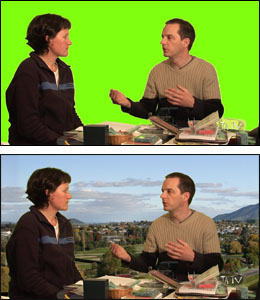 Filmmaking is not only an art. In the last 40
years, filmmakers has invented and developed new technological advances,
creating a dynamic, non-stop process that is still being developed nowadays.
Improvements in editing, cinematography, lighting and makeup have been improved
successfully. However, the most known achievement may be visual effects.
Filmmaking is not only an art. In the last 40
years, filmmakers has invented and developed new technological advances,
creating a dynamic, non-stop process that is still being developed nowadays.
Improvements in editing, cinematography, lighting and makeup have been improved
successfully. However, the most known achievement may be visual effects.
For this branch, a primal creation was the
chroma key. This widely known technique consists of using a green or blue
screen as the backdrop for the scenes, and then the colors are replaced for
images developed in a computer. This technique can be applied in flat surfaces,
and shaped elements as well.
 |
| Green screen used in Harry Potter and the Deathly Hallows - Part 2 |
A curiosity
about this technique is that has been everlasting. Since its invention in 1933
and improvement in the 70s, only the software and applications used to put the
image in the screen have been changed. Fortunately, the applications have
enough to develop a thorough result in image, making it to be quite similar to
the reality. The success in terms of image for films like Star Wars, Avatar or Alice in Wonderland is the product of
the use of this technique. Thanks to this technique, filmmakers have also
developed motion capture, which is making technological elements out of current
films.
Considering that this technique has replaced
several film labors like art direction, do you think that is a good element in
filmmaking? What is your opinion on visual effects on movies? For more
information check the site of KEYLIGHT, a keyer software for blue and green screen, and the video of
the use of chroma key for visual effects in Tim Burton’s Alice in Wonderland.
Chroma Key has been an incredible innovation in world cinema, think about the old times (since the advent of silent movies to 90's) the great effort that directors, producers and assistants scene had to make in order to bring the atmosphere of a dreamscape or fantastic to the concrete from limited resources. The introduction of multimodal means has made a change of roles, and now digital resources are allowed to create landscapes that have never been seen before, exploring then, a new way of thinking about contemporary film language.
ReplyDelete